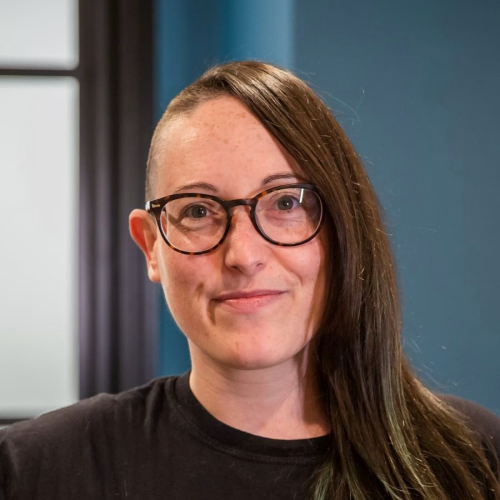Creating spaces for everybody: The key to designing with neurodiversity in mind
Designing office spaces that cater to everyone is complex. Senior Project Designer Tash Hewlett explores...
Neurodiversity Celebration Week challenges misconceptions about neurological differences while celebrating neurodiverse individuals and their talents.

Neurodiversity Celebration Week is a worldwide initiative that challenges misconceptions about neurological differences while celebrating neurodiverse individuals and their talents. Founded in 2018, it’s a week that aims to transform how neurodivergent people are perceived and supported in schools, universities and in the workplace.
This year, we hosted sessions and seminars throughout the week to improve our knowledge and understanding, enable us to become supportive colleagues to our neurodivergent teammates, and equip us with the ability to design workplaces better adapted to different neurological needs.
Neurodiversity describes the different ways people experience and interact with the world around them. According to Forbes, around 15-20% of the population is neurodiverse which covers ASD, ADHD, Dyslexia, Dyspraxia and many more neurological differences. First coined in the 1990s by sociologist Judy Singer, neurodiverse individuals exhibit various characteristics that are an asset to any team, while other traits cause challenges when it comes to navigating the work environment.



We started the week with neurodiversity training from Lisa Low at The Brain Charity, who offers emotional support, practical help and social activities to those with neurological conditions. Talking at Peldon Rose HQ, Sterling House, Lisa explained that while neurodiversity awareness in the workplace is increasing exponentially, there’s still much work to be done.
Typically, the environments we live and work in have been structured and designed with neurotypical individuals in mind. Neurotypical refers to individuals whose brains function in a similar way to most of their peers. However, it’s important to create environments that accommodate a broader spectrum of thought and behaviour.
The insights into the different strategies companies can adopt to create an inclusive culture show that it’s clear that this needs to be considered from recruitment through to retention. Some tactics include engaging senior leadership, developing supportive communications strategies and adopting a strengths-based review system. Lisa also shared information about assistive technologies and techniques that can be implemented to support neurodiverse employees.


Not only is it important to create a workplace culture that celebrates neurodiversity and recognises the challenges people may face, but it is also important to design a workplace with neurodivergent needs in mind.
Sarah Teichler from Teichler Consulting delivered a session to our design teams on how to equip workplaces for neurodiversity. Recognising that neurodiversity is a spectrum, inclusive design is first and foremost achieved by placing people and their needs at the heart of design. Some key considerations that Sarah recommends are:
A workplace should be designed with logic in mind. Intuitive and predictable office space planning can be easier for some neurodivergent people to navigate. While flexibility offers opportunity, it should be implemented mindfully, as too much change and uncertainty can overwhelm some individuals.
Large open spaces can be daunting to colleagues who suffer from anxiety, while cramped or crowded spaces can be overwhelming. Glazing, wall partitions or half height walls offer people the opportunity to anticipate different surroundings and adapt as they need to.
Here, the key is to strike a balance between information absence and information overload. Critically, wayfinding should not be used to decorate the workplace in artwork, as abstract signage is sometimes difficult to interpret.
Décor should be ideated with sensitivity in mind. Harsh, bold patterns and overly bright colours can cause sensory overload and conceptual furniture can be difficult to use. For the MS Society, Peldon Rose utilised neutral tones to accommodate for all.
Neurodiverse individuals respond better to natural daylight. Where this isn’t always possible, it’s important to consider lighting that can be adapted or dimmed, offering employees choice and control. Bulbs that release even a soft buzz can cause a distraction and coloured lighting challenges the ability to focus.
Too much sound can cause some individuals to feel overwhelmed, so noise travel throughout the workplace should be carefully considered. Acoustic panels or carefully placed furniture can help mitigate excess noise and create areas of quietness to ensure everyone can work in an environment suited to their preferences.
Some individuals are especially sensitive to scent. Ensuring that the workplace is well ventilated helps to monitor this, while encouraging colleagues to eat in the designated areas reduces the introduction of new, unanticipated smells.



Accommodating a broad range of individuals and diverse ways of thinking brings huge benefits to business. A variety of skills and perspectives allow creativity to flourish and innovation to thrive. For every individual to succeed, it’s important to create an environment where neurodivergence is accepted, with relevant measures to support those who need it. There’s more to learn and there’s a need to adapt, but we are committed to continually improving our understanding to create inclusive spaces for our colleagues and clients alike.

Designing office spaces that cater to everyone is complex. Senior Project Designer Tash Hewlett explores...

Learn more about how you can help underprivileged individuals make a good impression and kickstart their...

Tash Hewlett talks to Women in Office Design about Peldon Rose and the Sustainable Design Collective.

Your workplace holds enormous potential to improve your business performance. Get in touch today, and we will unlock that potential together.